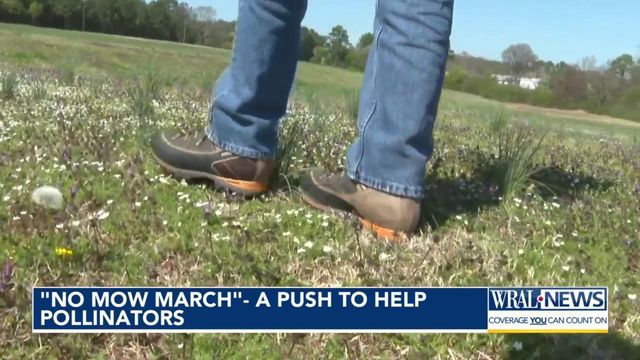Don't mow. Let it go. 'No Mow March' helps grass, pollinators thrive
There's a push to let lawns thrive this month.
Grady Miller, a professor who’s been studying turf grass at North Carolina State University for nearly two decades, says an initiative that started as "No Mow May" needs to be earlier in our region.
"It should probably be 'No Mow March' because we have many more flowering plants in the turf grass part of the landscape earlier in the year rather than later in the year," Miller said.
It's an effort to help pollinators that have been under threat from development and a warming climate.
The start of the growing season is an especially critical time for hungry, newly emerged native bees when floral resources may be hard to find, especially in urban and suburban landscapes.
"Henbit is a purple flower that's an early bloomer and common to see right now," Miller said. "Bees love them."
Miller says a warming climate has been a challenge for traditional grass species and has resulted in the "green up" happening earlier in the season.
"As we've gotten warmer and warmer, and we've had some dry years in the last 10 or 15 years, turf grass is suffering more, and we're having more and more trouble managing it, particularly during the hot months," Miller said.
Landscaper John Emerson, who's been in the business 24 years, says he's having to start lawn maintenance sooner in the year and veering away from traditional grass.
"There is low-maintenance cover such as clover or ornamental grasses that only have to be cut twice a year, and you can have habitat for birds and insects," Emerson said.
Cary resident Darrell Stover says he's never been a fan of mowing.
"It takes so much water, a bunch of work, and creativity ... I've got enough on my to do list," Stover said.
Now, he has switched to a natural lawn and says he gets to enjoy more time outdoors instead of maintaining it.
"Why not take in the beauty of – like I will – a field of clover with pollinators?" Stover said.
Experts say you can make a difference year-round by dedicating part of your yard to pollinator plants such as goldenrod, lavender, sun flowers and milkweed.
In addition to providing food for bees, these plants can attract butterflies and hummingbirds.













